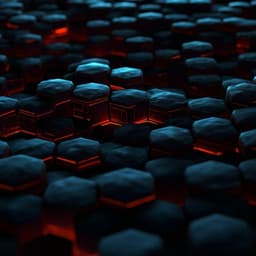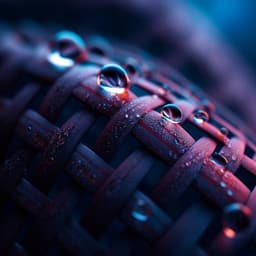
Engineering and Technology
Bio-inspired selective nodal decoupling for ultra-compliant interwoven lattices
Y. Mistry, O. Weeger, et al.
This innovative research showcases ultra-compliant interwoven lattices that achieve a remarkable tenfold compliance enhancement over traditional designs at equivalent volume fractions. The approach draws inspiration from the Venus flower basket sea sponge, providing a versatile blueprint for stiffness modulation in lattice structures. This groundbreaking work involves expertise from Yash Mistry, Oliver Weeger, Swapnil Morankar, Mandar Shinde, Siying Liu, Nikhilesh Chawla, Xiangfan Chen, Clint A. Penick, and Dhruv Bhate.
~3 min • Beginner • English
Introduction
The study addresses how to increase the compliance of lattice-based architected materials beyond conventional designs. While prior work emphasizes stretch-dominated lattices for high stiffness-to-weight ratios, the functional domain of high compliance for energy absorption and related applications is less explored. Drawing inspiration from the Venus flower basket (Euplectella aspergillum), which exhibits selectively decoupled nodes and interwoven strut systems in its immature lattice-like structure, the authors hypothesize that selectively decoupling lattice nodes to create interwoven architectures will significantly increase compliance. The purpose is to abstract this bio-inspired nodal decoupling principle and apply it broadly to common lattice topologies, evaluating its effect on mechanical response under compression. This is important for designing cellular materials where ultra-high compliance at given relative densities is desired, such as in energy absorption, sensing, and damping applications.
Literature Review
The paper situates its contribution within several strands of prior work: (i) Architected and cellular materials have been enabled by computational design and additive manufacturing, offering exceptional properties; most research optimizes for stiffness-to-weight via stretch-dominated lattices. (ii) Biological inspiration typically focuses on unit-cell topology, though meso-structural features (e.g., honeybee cell coping and corner radii) can enhance performance. (iii) The Venus flower basket has inspired designs using diagonal/helical reinforcements and hierarchical strategies; however, the early, woven-like state with selectively decoupled nodes has not been analyzed for mechanical benefits. (iv) 3D woven materials and wire-based woven meshes have been studied, along with interpenetrating lattices displaying negative stiffness and potential electromechanical coupling, and braided rope-like members showing higher compliance but challenging manufacturability. The present work differs by proposing a simple, generalizable approach—selective nodal decoupling of conventional lattices—to create interwoven 3D structures with unprecedented compliance, without substantially increasing manufacturing complexity relative to traditional beam lattices.
Methodology
Bio-inspiration and imaging: The Venus flower basket’s lattice was examined via X-ray microscopy (Zeiss Xradia Versa 620), revealing independent strut systems woven together with nodes selectively decoupled. Multiple scans (pixel size 23.5–8.4 µm) were processed in Avizo for multiscale visualization.
Design and generation of interwoven lattices: Using Rhino 7 with Grasshopper, traditional lattice unit cells (initially BCC) were converted into interwoven versions by selectively decoupling interior nodes. For BCC, the unit cell was split into two planes, each containing pairs of struts intersecting at the centroidal node. Struts were separated perpendicular to each plane by a prescribed interweaving (clearance) distance, forming two decoupled nodes in-plane; pairs of struts were merged to create an interwoven unit cell while retaining the eight corner nodes for periodicity. Similar procedures were applied to Diamond and Fluorite lattices (with more intersecting nodes) and to a hybrid FCC–BCC topology to confine FCC within a BCC framework, preserving periodicity. Rules: only interior nodes are decoupled; all nodes must remain in the tessellation volume; interweaving distance is limited to avoid node interference and ensure nodes remain within the unit cell; distance must exceed printer resolution to avoid merging.
Specimen geometry and fabrication: 45 mm cubic specimens (3 × 3 × 3 unit cells; unit cell size 15 mm in X, Y, Z) were generated for traditional and interwoven lattices (BCC, Diamond, Fluorite, BCC–FCC hybrid), with strut diameters of 1.2, 1.5, and 1.8 mm. Specimens included 4 mm thick platens. Three replicates per design/diameter were fabricated via Selective Laser Sintering (EOS FORMIGA P 110) in PA12. Measured strut diameters showed an average error of 5.25%.
Mechanical testing: Quasi-static compression tests were performed on an Instron 5985 with a 250 kN load cell at 1 mm/s, to densification. Load–displacement data were recorded; compliance was evaluated as the inverse of stiffness from the linear elastic regime. Digital imaging synchronized to time provided deformation visualization. To minimize edge effects for literature comparisons, larger 10 × 10 × 10 BCC and i-BCC specimens were also designed, fabricated, and tested per ISO 13314 guidance.
Numerical simulation: A nonlinear geometrically exact, shear-deformable 3D beam model with an elasto-visco-plastic material law for PA12 was used. PA12 behavior was characterized by uniaxial tension at multiple strain rates; a linear elasto-visco-plastic model (generalized Maxwell with parallel elasto-plastic and viscoelastic branches) was fitted. Beam structures were discretized via a B-spline isogeometric collocation method implemented in C++. Geometries were imported from Rhino/Grasshopper. To promote convergence under instabilities, small randomized geometric perturbations were applied. Boundary conditions mirrored experiments: bottom nodes fixed; uniform displacement applied to top nodes at 1 mm/s. Beam-to-beam contact was modeled via a penalty method. Simulations produced force–displacement responses and internal force distributions for BCC and i-BCC.
Data analysis: Effective modulus (E*) was normalized by base material modulus (Es) and plotted versus relative density (ρ*/ρs). A power law E*/Es = C (ρ*/ρs)^m was fitted for traditional and interwoven versions of all four lattice types, reporting C, m, and R^2. Homogeneity of internal force distribution and buckling localization were assessed via simulation at 30% effective strain (13 mm displacement). An Ashby chart aggregated normalized modulus data across literature cellular solids and the tested 10 × 10 × 10 lattices for benchmarking compliance.
Key Findings
- Interweaving via selective nodal decoupling dramatically increases compliance across multiple lattice topologies at similar relative densities.
- BCC case study: i-BCC specimens showed a 21.5-fold reduction in effective stiffness (i.e., increased compliance) relative to traditional BCC, with smoother plateau regions and mitigated load-drop undulations under compression.
- Simulations matched experimental force–displacement trends for BCC and i-BCC and revealed more homogeneous internal force distribution in i-BCC, with reduced localization of buckling and absence of failure bands that cause plateau undulations in traditional BCC.
- Generality across topologies: For Diamond, Fluorite, and BCC–FCC hybrid lattices, interweaving increased compliance by factors between 4 and 21 depending on cell type and relative density, while also smoothing the plateau response.
- Power-law scaling E*/Es = C (ρ*/ρs)^m: Interweaving increased the exponent m, indicating significantly greater compliance at a given relative density. Reported parameters:
• BCC: C = 0.13, m = 1.56 (traditional) → C = 10.06, m = 3.72 (interwoven), R^2 ≈ 0.99/0.98.
• Diamond: C = 1.26, m = 2.33 → C = 0.96, m = 2.91, R^2 = 0.99/0.99.
• Fluorite: C = 0.84, m = 2.34 → C = 0.30, m = 2.71, R^2 = 0.99/0.99.
• BCC–FCC: C = 0.08, m = 1.12 → C = 2.49, m = 2.77, R^2 = 0.96/0.77.
- Maxwell–Calladine interpretation: Interweaving introduces additional joints (without increasing strut count), reducing s − m and increasing the number of deformation mechanisms, making structures more bending-dominated and thus more compliant.
- Benchmarking: On an Ashby chart, interwoven lattices from this work are among the most compliant cellular materials at given relative densities, surpassed mainly by braided strut lattices that require far higher manufacturing resolution.
- Manufacturing implications: Selective nodal decoupling does not impose substantially stricter manufacturing constraints than traditional beam lattices, though some AM processes may need support structures.
Discussion
The findings confirm the hypothesis that selectively decoupling interior nodes to interweave struts substantially enhances the deformability of bending-dominated lattices. Mechanistically, added joints increase available kinematic mechanisms (per Maxwell–Calladine), distributing loads more uniformly and reducing buckling localization and plateau undulations. The power-law exponent m consistently increases across all tested topologies, demonstrating a topology-agnostic pathway to modulate stiffness–compliance trade-offs at fixed relative density. This suggests a near-universal design knob for tailoring compliance in architected materials, even potentially for traditionally stretch-dominated lattices. Compared to prior woven or interpenetrating lattice designs, the proposed method achieves extremely high compliance with simpler manufacturability relative to braided-strut approaches. The Ashby plot context underscores that interwoven lattices occupy the ultra-compliant frontier among cellular solids at comparable densities. Practical implications include improved energy absorption, vibration damping, and transduction in devices requiring high compliance, with minimal added fabrication complexity for common AM platforms.
Conclusion
Inspired by the Venus flower basket’s selectively decoupled nodes, the study introduces a generalizable strategy—selective nodal decoupling—to create interwoven lattice architectures that achieve up to ~20-fold higher compliance than traditional counterparts at similar relative densities. The approach applies across multiple lattice topologies (BCC, Diamond, Fluorite, BCC–FCC hybrid), increases the stiffness–density power-law exponent, smooths compression plateaus, and reduces internal force concentrations. Benchmarking shows these interwoven lattices among the most compliant reported. Future directions include: (i) optimizing interweaving distance locally to tune compliance; (ii) spatially selective decoupling for graded compliance; (iii) extending to surface-based structures such as TPMS lattices; and (iv) further exploring the biological relevance to early-stage sponge mechanics. The method holds promise for applications in compliant sensing, energy absorption, and damping where high compliance at elevated relative densities is advantageous.
Limitations
- Material system limited to PA12; although the principle is expected to generalize, cross-material validation was not performed here.
- Primary loading condition was quasi-static compression; behavior under tension, shear, fatigue, and dynamic impacts remains to be explored.
- Most tests used 3 × 3 × 3 unit-cell specimens; while additional 10 × 10 × 10 tests were conducted for BCC/i-BCC, broader large-specimen validation across all topologies would further minimize edge effects.
- Interweaving distance was fixed for reported designs; systematic parametric studies of decoupling distance and geometric tolerances were not exhaustively covered.
- The cylindrical global architecture of the Venus flower basket was not modeled; links between nodal decoupling and organism-level resilience remain speculative.
- Some AM processes may require supports for interwoven geometries; manufacturability across platforms and scales needs further assessment.
- Simulations used a simplified linear elasto-visco-plastic material model; more detailed constitutive descriptions and contact modeling could refine predictions.
Related Publications
Explore these studies to deepen your understanding of the subject.







